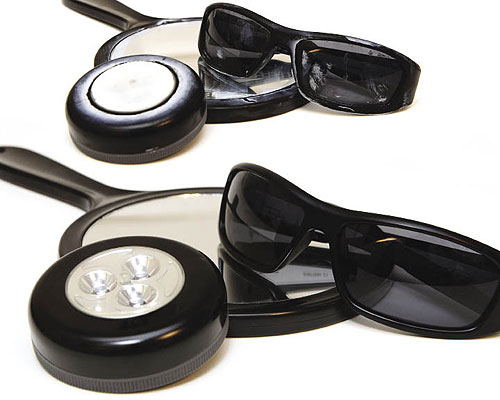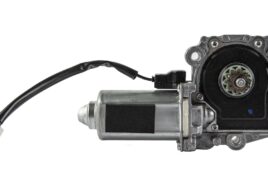by Josh Sherwood, OEM Market Manager, Henkel Corp.
Cyanoacrylates (CAs) are one-part instant adhesives that fix rapidly and cure at room temperature. They bond to a range of components, including metals, plastics, elastomers, and porous substrates. When exposed to a weak base such as water, CAs polymerize. The water neutralizes acidic stabilizers in the adhesive, initiating rapid cure—obtaining fixture strength in just seconds and full strength within 24 hours.

Items in the rear of the photo are covered with blooming or frosting from regular instant adhesives, while items in the front are clean and bloom-free using Low Odor/Low Bloom Instant Adhesives.
These dry, colorless adhesives are easy to use and automate. Their cure speed increases throughput and reduces per piece processing costs. But CAs are prone to blooming or frosting, a cosmetically unappealing phenomenon that manifests itself as a rainbow or whitish haze surrounding the bond line. Blooming occurs when unreacted cyanoacrylate monomers evaporate and become airborne. Because they are heavier than air, these molecules tend to fall back onto the surface of the part outside of the bond line in the form of white flakes. In great numbers, these flakes create a hazy or frosted appearance on the part.
The rainbow haze is due to a small concentration of cyanoacrylate particles on the surface. Light hitting the surface is diffracted causing the rainbow effect. The whitish haze surrounding the rainbow is due to a relatively higher concentration of cyanoacrylate monomer.
Blooming has no negative effects on the strength and durability of the bond. While blooming is desired in some CA applications like fingerprint detection, this purely aesthetic problem is viewed as a detriment in applications where a clean bond line is critical, for example on cosmetic cases, medical equipment, electronic devices, pharmaceutical packages, appliances, automotive parts, and speakers.
The following tips can help reduce or eliminate the potential for blooming or frosting of instant adhesives.
1. Use low-odor, low-bloom instant adhesives – These adhesives use cyanoacrylate monomers with higher molecular weights than those of traditional CAs, which make them less likely to become airborne than standard cyanoacrylate monomers, reducing blooming and chemical odors.
2. Use flashcure or light cure CAs – These adhesives combine cyanoacrylate and light cure technology to cure tack-free in less than 5 seconds rather than the 30 seconds required by regular instant adhesives. This extremely rapid cure eliminates the possibility of blooming because the adhesive never has a chance to become airborne.
3. Avoid large fillets – Fillets are areas along the bond line where adhesive squeezes out or reaches just beyond the edge of the substrate. This provides an ideal opportunity for blooming to occur, as the adhesive is completely exposed to the open air. By keeping the adhesive within the bond line and minimizing substrate-level exposure, less adhesive will be available to become airborne and migrate beyond the bond line.
4. Increase air flow – Avoid assembling parts and immediately placing them in an airtight environment such as a bag or shipping container. Cross ventilation helps carry airborne CA molecules away from the bond area, minimizing the number of molecules available to fall back to the bond line area.
5. Use accelerators – The faster the adhesive cures, the lower the chance there will be unreacted cyanoacrylate monomers that become airborne. Adding an accelerator to speed the rate of cure reduces the chances of frosting. But cure speed must be carefully managed—the heat generated by too fast a cure may result in a phenomenon similar to frosting where the rapid exothermic reaction drives off unreacted monomer.
6. Avoid acidic surfaces – Acidic surfaces slow down the cyanoacrylate cure mechanism and keep the adhesive uncured longer. When bonding acidic surfaces, rinse to reduce acidity or choose an adhesive or accelerator designed to work under these conditions such as a surface insensitive instant adhesive.
7. Avoid extremes in relative humidity – If relative humidity is too low, the adhesive will take longer to cure. If it’s too high, the curing reaction may occur too quickly and exothermic reaction may allow blooming to occur. Relative humidity of 40 to 80% is recommended for cyanoacrylate cure.
8. Avoid extremes in temperature – Elevated temperatures promote the vapor pressure or volatility of the CA monomer, leading to higher blooming vulnerability. Conversely, lower temperatures slow the reaction mechanism, causing prolonged cure time and opportunity for the CA monomer to become airborne. A temperature controlled environment as close to 70°F is ideal.
9. Avoid the use of old material – Old product does not cure as quickly as fresh material. And when cure is slowed, there is more opportunity for adhesive particles to become airborne and for blooming to occur.
Henkel Corp.
www.henkel.com
Filed Under: Adhesives • epoxies, Material handling • converting, MORE INDUSTRIES





I glued a glass ball on top of a small bottle filled with Swarovski crystals to seal it. Some of the bottles have lots of white bloom and some none. I used Aleene’s jewelry and metal glue. It contains ethyl cyanoocrylate. Could you recommend one of your glues that would not have the white bloom ?
Hello Lynda
I would suggest taking a look at low bloom CAs, something like Permabond 94x series.
Or you may use clean and efficient UV-cured adhesives. Their cure process is controlled with UV lamp.
I know people who make jewelry and use UV cured adhesives, as they are clear, quick bonding and aesthetically reliable (non-yellowing, non-bloming etc.).